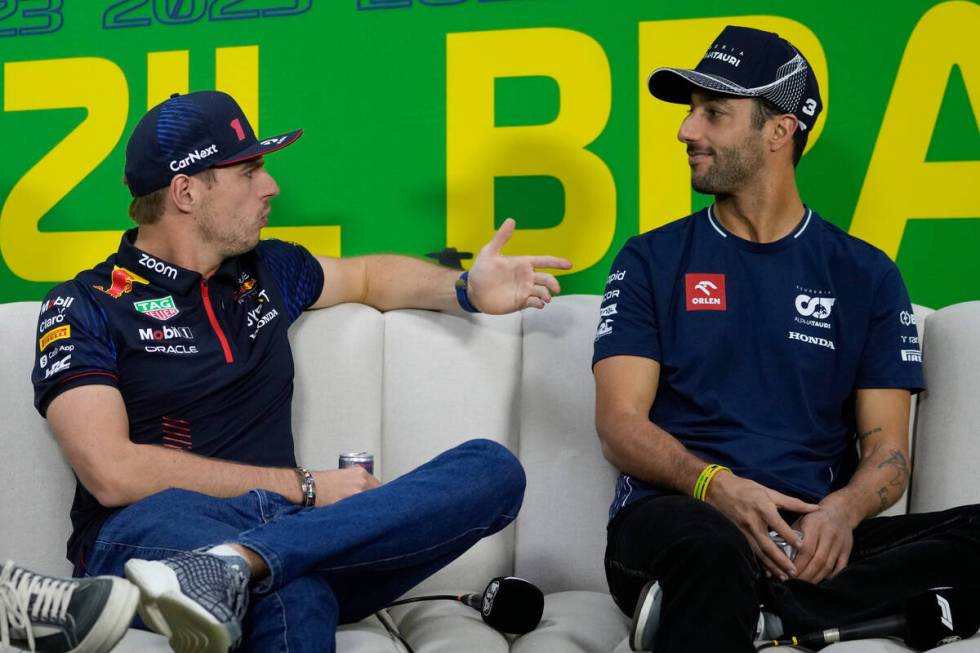How a Netflix show helped bring Formula One back to Las Vegas

Formula One is returning to Las Vegas for the first time in more than four decades. A reality show on Netflix is a major reason why.
F1, considered the pinnacle of worldwide motor sports, has a long history in the United States. Yet F1’s American viewership stagnated for decades until the debut of Netflix’s “Formula One: Drive to Survive.”
A nonscripted reality sports docudrama that debuted in 2019, “Drive to Survive” chronicles each F1 season, interviewing drivers, team principals, journalists and others around the sport. The show focuses less on the technical development of the cars or strategy of the races, and instead follows the drivers and teams.
The series is somewhat controversial. Die-hard F1 fans point out that in-race radio and even interviews have been used out of context, and reigning three-time champion Max Verstappen refused to participate in seasons two through four after disagreeing with his portrayal in season one. He returned for season five.
Each season is 10 episodes. Season five covered the 2022 season and was released Feb. 24. Season six, which will cover the 2023 F1 campaign, is in development.
“Drive to Survive” has fueled American interest in the sport. ESPN announced Formula One averaged 547,772 viewers per race in 2018, the first year covered by “Drive to Survive” and the last season of F1 before the series was released. In 2022, ESPN said F1 races had 1.21 million viewers per race, the circuit’s most-viewed season ever in the U.S.
American interest, along with American ownership of Formula One itself, has led to more races here. The United States Grand Prix still runs at the Circuit of the Americas in Austin, Texas, where it’s been since 2012. The Miami Grand Prix was introduced in 2022.
The Las Vegas Grand Prix’s debut this week makes the U.S. the only country to host three races.
Here’s a brief primer on what happened in the first five seasons of “Drive to Survive”:
Season one is mainly focused on introducing fans to Formula One.
Each team develops its own cars, which creates a unique dynamic. Drivers want to prove themselves as the best, yet the only other driver on the grid with a technologically level playing field is their teammate. Drivers must cooperate with each other to help score points for their teams and get more money to develop better cars, but also need to show they can be world championship-caliber drivers and consistently outscore their teammates.
Mercedes and Ferrari, which finished first and second in the constructors’ standings in 2018, refused to participate, so “Drive to Survive” spent a lot of the season with Haas team principal Guenther Steiner and Red Bull’s Daniel Ricciardo.
Additionally, Red Bull team principal Christian Horner feuds with Renault, Red Bull’s engine producer, over the team’s lack of input about the engine-building process. Charles Leclerc joins Ferrari after just one season in F1, and Esteban Ocon loses his seat at Force India after the financially beleaguered team is bought by a consortium led by Lawrence Stroll, who installs his son Lance Stroll as one of the new drivers.
Ricciardo announces he will leave Red Bull for Renault during the climax of season one, allowing Verstappen to become the undisputed No. 1 driver on the team.
Season two includes Mercedes and Ferrari, but the biggest storyline follows second-year driver Pierre Gasly as he tries to replace Ricciardo at Red Bull. He is demoted for rookie Alex Albon after underperforming, but Gasly claims his first podium at the Brazilian Grand Prix. Carlos Sainz, who lost his seat at Renault to Ricciardo, shines at his new team, McLaren.
Nico Hulkenberg is released by Renault for Ocon, meaning the his record podium drought will continue indefinitely, Red Bull turns to Honda as an engine provider, and Haas’ new partnership with an energy drink company fails spectacularly.
Season three is mainly focused on Formula One dealing with the COVID-19 pandemic. Gasly scores his first F1 win at the 2020 Italian Grand Prix, and Racing Point is accused of copying Mercedes’ 2019 title-winning car.
Ricciardo announces he will leave Renault for McLaren, while Sainz moves to Ferrari to replace four-time world champion Sebastian Vettel, who is joining Racing Point, formerly Race India, which rebrands again as Aston Martin.
Vettel’s move means Mexican driver Sergio Perez may be out of Formula One, but his heroic last-to-first drive for the first F1 win of his long career at the 2020 Sakhir Grand Prix earns him a spot at Red Bull, replacing a struggling Albon.
Season four follows the tightly contested 2021 championship battle that Verstappen won over Lewis Hamilton in the final race, along with Valtteri Bottas’ departure from Mercedes after five successful seasons for rising prodigy George Russell.
Season five’s major plotline is the Oscar Piastri situation. Fernando Alonso announces he is taking the retiring Vettel’s seat at Aston Martin, and Alpine — formerly Renault — offers the drive to Piastri, who refuses and joins McLaren, leaving Ricciardo without a seat. Gasly gets the open Alpine spot, and Verstappen destroys Ferrari in the second half of the season to claim his second consecutive championship.
Contact reporter Andy Yamashita at ayamashita@reviewjournal.com. Follow @ANYamashita on X.